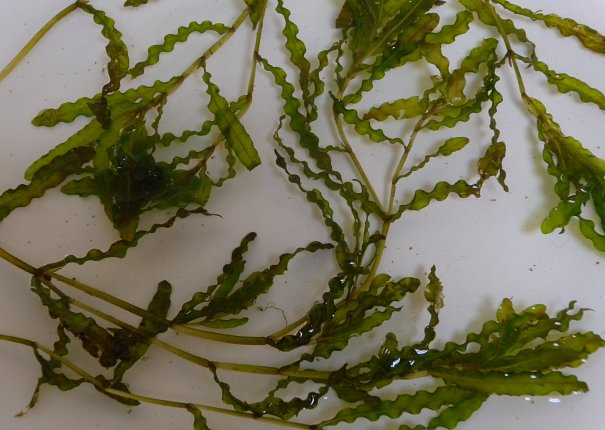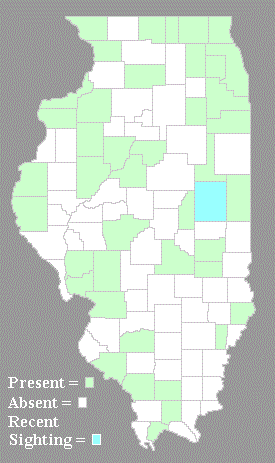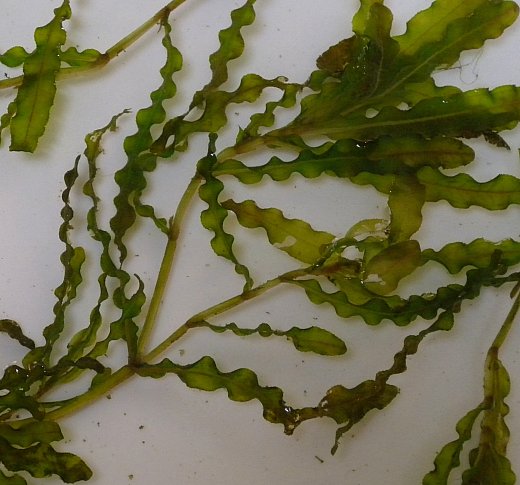
Upper stems occasionally terminate in short cylindrical spikes of flowers about ½-1" (12-24 mm.) in length. Less often, such spikes of flowers are produced from the axils of upper leaves. Their naked peduncles are ¾-3½" long; they hold the floral spikes slightly above the water surface. Individual flowers are quite small (about 1/8" or 3 mm. across), consisting of 4 greenish brown or greenish red sepals (or sepaloid connectives), 4 anthers, and 4 ovules. The blooming period usually occurs from late spring to early summer for about 1-2 weeks, although some plants may bloom later. The flowers are cross-pollinated by wind or water. Afterwards, the flowers are replaced by flattened achenes about 4-6 mm. in length that have long beaks (up to 4 achenes per flower). In addition to the achenes, this plant also produces winter buds (turions) from the tips of stems and the axils of leaves. These winter buds resemble congested rosettes of holly-like leaves spanning about 2 cm. across at maturity; they have a bur-like or cone-like appearance and stiff texture. After the achenes and winter buds are produced and released, the entire plant withers away during the summer. The winter buds drift in the water and eventually sink to the bottom of the body of water, where they can take root during the autumn, forming new plants that can survive the winter. The root system is fibrous.

Cultivation: This aquatic plant prefers to grow in sunny locations where the water is 1-10' deep, clear to slightly turbid, and relatively stagnant to slow-moving. In addition, calcareous water that is relatively high in nutrients is preferred (pH 6.5-8.5). Substrates that are soft and muddy from decomposing organic matter are preferred, although sandy substrates and hard substrates are tolerated. This aquatic plant also tolerates water pollution to a greater extent than most pondweeds (Potamogeton spp.). Reproduction occurs primarily by means of winter buds (turions). Seeds quickly lose their vitality if they are allowed to dry out. In many areas of North America, Curly Pondweed is invasive, forming large dense colonies that can displace native aquatic plants. In these areas, it should not be cultivated. When large colonies of this plant die-off during the summer, this can cause excessive growth of filamentous algae and low levels of oxygen in the water as a result of the release of surplus nutrients.
Range & Habitat: Curly Pondweed is occasional to locally common throughout Illinois, where it is not native. It was introduced into North America from Eurasia during the 19th century, possibly as an aquarium plant. Habitats consist of ponds, sheltered areas of lakes, slow-moving rivers, spring-fed sloughs, and drainage canals. This plant has spread to new areas by means of discarded water from aquariums, fish-stocking operations, by clinging to the propellers and trailers of motorboats, and by drifting downstream. It is often found in degraded wetlands that are exposed to either urban development or recreational activity in park areas. At some locations, it can become dominant, displacing other aquatic plants, by forming dense colonies.
Faunal Associations: Little is known about floral-faunal relationships for Curly Pondweed in North America, although it is probably similar to other submerged pondweeds (Potamogeton spp.). For example, such insects as the larvae of some aquatic beetles (Neohaemonia spp., Donacia spp.), the larvae of some shore flies (Hydrellia spp.), and the larvae of some caddisflies (Leptoceridae) probably feed on the submerged foliage of Curly Pondweed. The larvae of an introduced European moth, Acentropus niveus, feed on the foliage of Curly Pondweed, but they also feed on the foliage of many other aquatic plants. In addition, the larvae of some midges (Chironomidae) may bore into parts of the foliage, where they usually function as filter-feeders of micro-organisms. In general, both the seedheads and foliage of pondweeds are an important source of food to many kinds waterfowl and other wetland birds (Martin et al. 1951/1961). However, the stiff texture of the foliage of Curly Pondweed may decrease its food value to such wildlife somewhat. There is some evidence that the Common Carp (Cyprinus carpio) feeds on this plant, but not enough to function as an effective bio-control agent.

Photographic Location: This plant was growing in a drainage canal in Urbana, Illinois, and photographed indoors.
Comments: Curly Pondweed is the only non-native pondweed (Potamogeton) that is known to have naturalized in Illinois. Because of its distinctive leaves with curly margins that are finely serrated, it is easy to recognize. For this reason, it is sometimes referred to as Beginner's Pondweed. Unfortunately, this pondweed has become increasingly common with the passage of the years, therefore it should be considered invasive. Once it becomes established, there is really no easy way to get rid of it without destroying all of the other aquatic plant species in a body of water (e.g., by the use of herbicides).